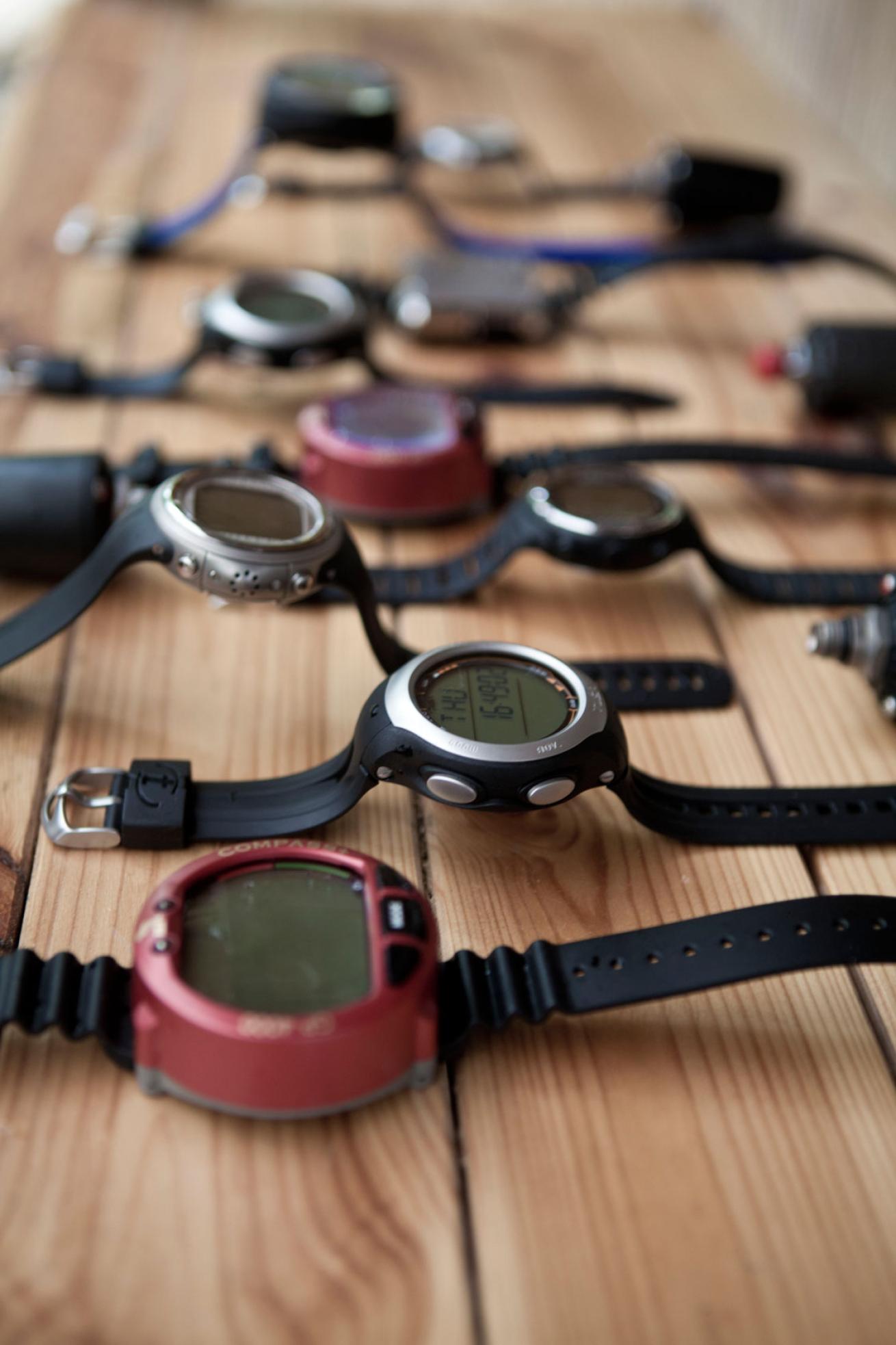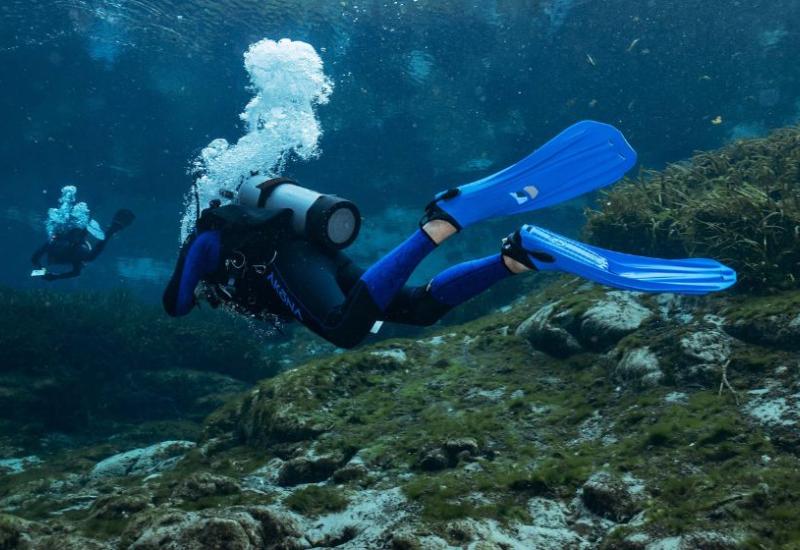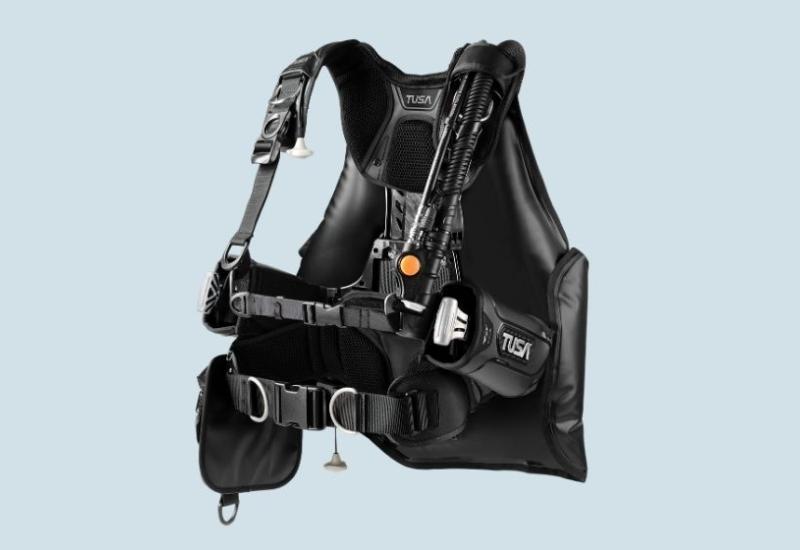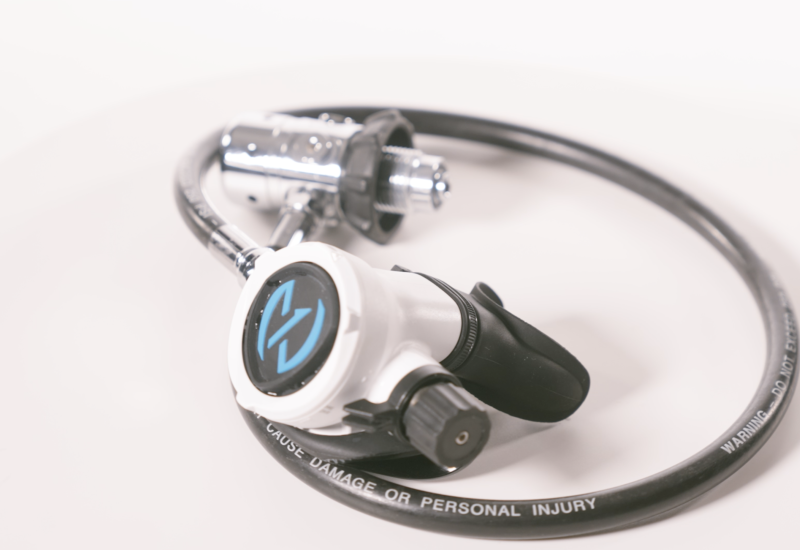ScubaLab: 2011 Dive Computer Sneak Peek

ScubaLab: 2011 Dive Computer Test
Courtney Michalik
For space reasons, we had to leave out two models from the published results in Scuba Diving magazine (in the September/October issue, which is on the newsstand now). The Suunto D6i was tested along with its sister models, the D4i and D9tx. First reviewed in August 2009, we also decided to revisit the Suunto HelO2 in honor of the new D9tx computer. Here are the results.
SUUNTO D6i
SPECS
Mounting Options Wristwatch Operational Modes Watch, Air, Nitrox, Freedive, Gauge Gas Mixes 2 User Controls 4 Push Buttons Air-Integrated Yes (optional transmitter) PC Kit Optional
www.suunto.com/diving
TEST STATS
Real-World Performance 4 (VERY GOOD)
PERFORMANCE
Just as the D4i, the D6i retains the basic interface and features of the standard D6 model with the addition of wireless air integration and a 3D tilt compensated digital compass. The 3D compass is accurate and divers do not need to overly concern themselves with the orientation of the computer, as it will provide useful navigation information under a variety of angles. With the addition of a Freedive mode, the new matrix display, chronograph functions in the dive modes, and more profile sampling rate options, the D6i is one of the most complete dive computer systems on the market. Our testers found the D6i easy to configure and the menus relatively simple to navigate. As with the other “D” series computers, the data display is small but easy to read and makes efficient use of available space, and the backlighting is excellent.
LIBERAL OR CONSERVATIVE
Utilizing the same RGBM model as the D4i, the D6i was Moderate to Liberal in most objective test profiles and only yielded conservative figures in one test. To increase the margin of safety there are three user adjustable personal factors.
BOTTOM LINE
At nearly $1000 without a transmitter, the D6i is outside the price range of many divers, but it has all the features a hard-core diving enthusiast wants in the attractive “D” series wristwatch style.
TECH COMPUTER SYSTEM
SUUNTO HELO2
SPECS
Mounting Options Wrist-Mount Operational Modes Mixed, Gauge Gas Mixes 8 User Controls 4 Push Buttons Air-Integrated Yes (optional transmitter) PC Kit Included
www.suunto.com/diving
We decided to revisit the Suunto HelO2 and compare it to the new D9tx computer. Since both systems use similar models and programming, it was expected that the D9tx would perform similarly to the HelO2 in actual mixed gas diving situations. To evaluate the system, we asked local expert, Peter Friedman, to take the HelO2 out and put it through a few tec dives to see how the system functions in the real-world. Here is his evaluation:
“I dove the Suunto Hel02 computer this week to test how it performed as a technical computer. Unfortunately, I was not able to test it with a helium mix, but I used it on a series of deeper dives; switching gas mixes during some of the dives. I am pleased to report that the unit was much easier to use and worked much better than my initial expectations. Changing gases during the dive was easy and intuitive, and I found that the prompt to switch gases was very near the depths from my pre-dive plan. I found the HelO2 to be slightly more conservative than some of the tables I ran previous to the dive, but I was diving the unit on its factory default and the computer does have a -1 and -2 setting for a more liberal profile. The unit also has the ability to increase conservatism in situations such as a strenuous dive or in very cold water. The deep stop was an issue, and I was surprised that I could not find any easy way to turn it off. Reading the manual provided no answer. In fact, it clearly states that you will be penalized on subsequent dives for not stopping, but missing this stop will not cause the unit to error out. Having a background in RF engineering, I am very skeptical of underwater transmitters and would never dive without an analog gauge; however, the pressure reading seemed to be working very well and I did like having that information accessible on my wrist. While the manual states the on-gassing rates used, it does not list the off-gassing rate other than to say that it is slowed down. Any other problems I had with the unit can be attributed to unfamiliarity with the system. All in all, I was impressed with the performance and function of this computer."
Peter Friedman is a course director for NAUI in both technical and recreational disciplines, an instructor for TDI, SDI and others, and an electrical engineer experienced in RF technology and computer engineering.
You can also heck out the 2010 results—at the time of our 2011 testing, many of these models were still available on store shelves.

Courtney Michalik
For space reasons, we had to leave out two models from the published results in Scuba Diving magazine (in the September/October issue, which is on the newsstand now). The Suunto D6i was tested along with its sister models, the D4i and D9tx. First reviewed in August 2009, we also decided to revisit the Suunto HelO2 in honor of the new D9tx computer. Here are the results.
SUUNTO D6i
SPECS
Mounting Options Wristwatch Operational Modes Watch, Air, Nitrox, Freedive, Gauge Gas Mixes 2 User Controls 4 Push Buttons Air-Integrated Yes (optional transmitter) PC Kit Optional
www.suunto.com/diving
TEST STATS
Real-World Performance 4 (VERY GOOD)
PERFORMANCE
Just as the D4i, the D6i retains the basic interface and features of the standard D6 model with the addition of wireless air integration and a 3D tilt compensated digital compass. The 3D compass is accurate and divers do not need to overly concern themselves with the orientation of the computer, as it will provide useful navigation information under a variety of angles. With the addition of a Freedive mode, the new matrix display, chronograph functions in the dive modes, and more profile sampling rate options, the D6i is one of the most complete dive computer systems on the market. Our testers found the D6i easy to configure and the menus relatively simple to navigate. As with the other “D” series computers, the data display is small but easy to read and makes efficient use of available space, and the backlighting is excellent.
LIBERAL OR CONSERVATIVE
Utilizing the same RGBM model as the D4i, the D6i was Moderate to Liberal in most objective test profiles and only yielded conservative figures in one test. To increase the margin of safety there are three user adjustable personal factors.
BOTTOM LINE
At nearly $1000 without a transmitter, the D6i is outside the price range of many divers, but it has all the features a hard-core diving enthusiast wants in the attractive “D” series wristwatch style.
TECH COMPUTER SYSTEM
SUUNTO HELO2
SPECS
Mounting Options Wrist-Mount Operational Modes Mixed, Gauge Gas Mixes 8 User Controls 4 Push Buttons Air-Integrated Yes (optional transmitter) PC Kit Included
www.suunto.com/diving
We decided to revisit the Suunto HelO2 and compare it to the new D9tx computer. Since both systems use similar models and programming, it was expected that the D9tx would perform similarly to the HelO2 in actual mixed gas diving situations. To evaluate the system, we asked local expert, Peter Friedman, to take the HelO2 out and put it through a few tec dives to see how the system functions in the real-world. Here is his evaluation:
“I dove the Suunto Hel02 computer this week to test how it performed as a technical computer. Unfortunately, I was not able to test it with a helium mix, but I used it on a series of deeper dives; switching gas mixes during some of the dives. I am pleased to report that the unit was much easier to use and worked much better than my initial expectations. Changing gases during the dive was easy and intuitive, and I found that the prompt to switch gases was very near the depths from my pre-dive plan. I found the HelO2 to be slightly more conservative than some of the tables I ran previous to the dive, but I was diving the unit on its factory default and the computer does have a -1 and -2 setting for a more liberal profile. The unit also has the ability to increase conservatism in situations such as a strenuous dive or in very cold water. The deep stop was an issue, and I was surprised that I could not find any easy way to turn it off. Reading the manual provided no answer. In fact, it clearly states that you will be penalized on subsequent dives for not stopping, but missing this stop will not cause the unit to error out. Having a background in RF engineering, I am very skeptical of underwater transmitters and would never dive without an analog gauge; however, the pressure reading seemed to be working very well and I did like having that information accessible on my wrist. While the manual states the on-gassing rates used, it does not list the off-gassing rate other than to say that it is slowed down. Any other problems I had with the unit can be attributed to unfamiliarity with the system. All in all, I was impressed with the performance and function of this computer."
Peter Friedman is a course director for NAUI in both technical and recreational disciplines, an instructor for TDI, SDI and others, and an electrical engineer experienced in RF technology and computer engineering.
You can also heck out the 2010 results—at the time of our 2011 testing, many of these models were still available on store shelves.










